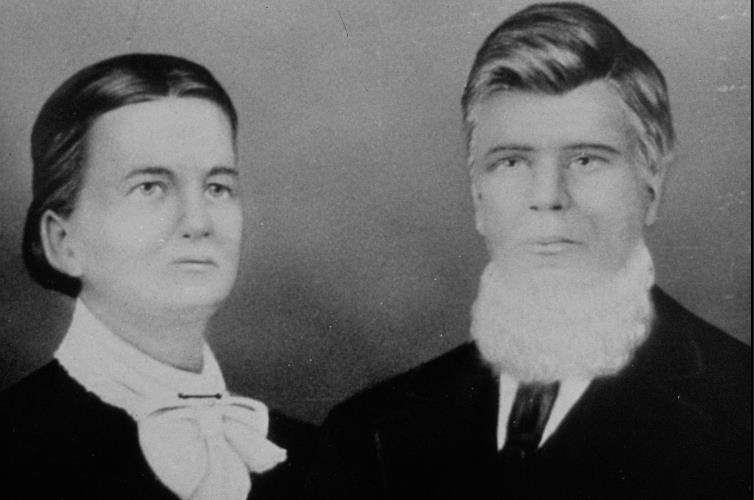
by Laura Knight
~~~
Jesse and Rebecca Knight were my great-great-grandparents.

Jesse Knight and wife, Rebecca Caroline Varn Knight
From "The History of Sarasota"
Among the earliest settlers were Jesse and Rebecca Varn Knight and their children, who came to Florida around 1853, first settling in Hillsborough County. They had married when Rebecca was just 16, and he was 22. Their large family consisted of seven boys and eight girls.
Jesse raised cattle in Georgia but could not afford to buy more land there to expand his herd and decided to move farther south.
Herding the cattle for the long, arduous journey — it took over a year to reach Hillsborough — they homesteaded in an area that became known as Knight’s Station, near Tampa.
When the Civil War erupted in 1861, Knight moved his livestock south, near the Upper Myakka Lake, to prevent Union troops from requisitioning them.
After the war ended in 1865, the Knight herd numbered approximately 300. According to historian Karl Grismer, Knight wanted to move them to an area where they would have more room to freely graze. “The Knights, along with three other families, eight covered wagons drawn by oxen, three buggies drawn by mules, seven mounted horses and 300 head of cattle began the trip.”
They headed for Horse and Chaise, so named because of the way the silhouette of land looked from the water — a horse and a chaise. Today this is Venice-Nokomis. The 60-mile journey took nearly a month.
The story goes that when they got to a creek that Knight’s buggy mule refused to cross, Jesse told one of his sons to take a shakit, a dried piece of buckskin, and slap the mule with it. The sound of the shakit startled the mule, giving it enough motivation to cross. The creek became known as Shakit Creek — today’s Shakett Creek.
Knight was a deeply religious man, a Methodist minister who founded the Venice-Nokomis Church. According to Grismer, he alternated conducting services with another settler, Isaac A. Redd, a Missionary Baptist and founder of the Bee Ridge community.
Initially, services were held in settler homes but as the need for a larger facility became apparent, Knight and his family and neighbors constructed a plank church in Nokomis used by Methodists with Knight as pastor. The church also served as a school. Although never ordained, he was known throughout the area as the Reverend Jesse Knight.
As Grismer wrote, “Many members of the congregation came to the services by boat, down the creeks and bays to a boathouse at Venice inlet, where they would change into their Sunday clothes and walk the rest of the way to the church.”
Knight proved a successful rancher. According to Grismer, “Jesse Knight established a veritable kingdom of his own, dominating the entire region southeast of Horse and Chaise.”
Area cattlemen were selling much of their stock to Cuba. And during the Spanish American War, many head were sold to the U.S. Army, stationed in Tampa. Grismer noted that cattlemen made a killing as prices rose to new heights. Jesse’s herd multiplied to 20,000 head.
After years of toil and success, Rebecca, who was born in 1825, died in 1901. She was remembered by those who knew her as “a worthy woman as evidenced in the lives of her noble and saintly daughters as well as the sons who were blessed by her faithful training.” She is buried in the Jesse Knight Memorial Cemetery in Nokomis.
Jesse was 94 when he passed away in 1901, and rests next to his beloved wife, a short distance from their original homestead.
Being such a large family, the Knight descendants still contribute to Sarasota’s success. One member of the family, Jon Thaxton, was a highly regarded Sarasota County commissioner active in the community.
Venice-Nokomis United Methodist Church was established in 1868 by Jesse Knight, one of the first settlers in this territory. His first homestead was near Tampa but during the war he moved south to the Upper Myakka Lake area. The cattle did exceptional well in Myakka but Jesse didn’t want to live inland - he preferred the coast. He finally selected to reside in Horse & Chaise. The community got its peculiar name from a growth of timber on a promontory facing the open Gulf of Mexico. Two clumps of trees stood there and seamen coming up the coast swore that one clump looked exactly like a horse and the other exactly like a chaise. The community of Horse & Chaise was later renamed Nokomis. Karl H. Grismer describes the Knight family’s arrival in his book “The Story of Sarasota” as follows:
“The Knights suffered a minor disaster when they were almost in sight of the Gulf. They came to a board creek, near the head of Dona Bay, which they had to ford. The mules pulling the leading buggy refused to budge. Knight tried to coax them to enter the water by holding ears of corn in front of their mouths. But the stubborn animals would not be tempted. Whips were swung but still the mules stood rooted in their tracks. Finally Knight had an idea. He yelled to his oldest son: 'Bill, in that second cart there are some dried deer hides. You know, they make a wicked, cracking noise when you handle them. Get one of those hides and stand just behind those critters and then take the hide and sort of shake it - and sort of not shake it.' Bill got the idea. He hurried back to the cart, pulled out a large hide, and stood alongside the team of balky mules. Then he shook the hide - not rather lightly, as his father had suggested, but with all his strength. The shaking hide sounded like exploding firecrackers. Frightened, the mules leaped forward, splashing through the creek. The result was near catastrophe. Two of the buggies and a heavily loaded cart upset in the creek and many of Knight's belongings went overboard. Because of this proof on the super-efficiency of shaken deer hides, the creek became known as Shakit Creek."
 |
After succeeding in getting the entire caravan across the creek and providing shelter for his family, Jesse gathered his wife and fifteen children around him to read the scriptures, thank God for their safe journey, and ask for His guidance in the future. This event is considered to be the first worship service held in the area and established what later became known as Venice-Nokomis United Methodist Church. The Knights became one of the leading families on the West Coast. Jesse, a staunch Methodist, became known throughout the region as the Rev. Jesse Knight even though he was never officially ordained |
| As more people settled in Nokomis the Knight’s home became too small to hold the worship services. Rev. Knight built an arbor on his property consisting of an open frame and roofed with palm fronds to keep the sun out. This arbor was used as the Church for about five years. | 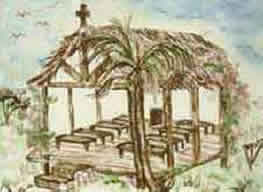 |
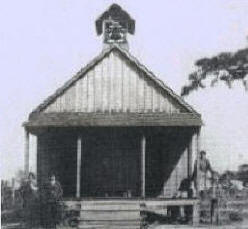 |
The community continued to grow and the need to provide an education for the increasing number of children had to be addressed. In 1893 Rev. Knight donated land and supplied the lumber for a Schoolhouse to be constructed. The lumber came from the nearest sawmill, located at Cedar Key, and was delivered by sailboat. The School house was small (18' x 24') and only contained straight benches. It also served as the Church. |
By 1903, the Schoolhouse/Church had outgrown the facility so Rev. Knight once again provided the land and a separate church building was constructed.. This Church had stained glass windows, a belfry, and a cast iron bell. Our Church obtained the bell in the late 1800's. Its original use was on an old "iron horse," coal and wood-burning locomotive. Its sound became the familiar call to worship for those who resided in the area. When Rev. Knight died at the age of 94, the bell was tolled 94 times in his honor. |
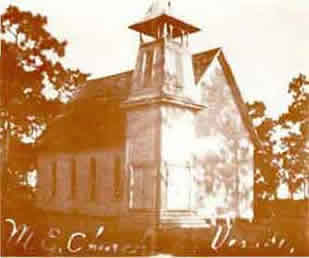 |
Notice the word “Venice” written across the photograph of the first Church. Venice was later moved south of Roberts Bay and Nokomis named for the area north of Roberts Bay.
This first Church was built on a piece of property that today is recognized as an historical landmark for being the area’s first cemetery. The Knight Memorial Cemetery is located on Colonial Lane in Nokomis, Florida. The cemetery is about 300 feet north of the Knight’s first home. The name was changed from “The Nokomis Cemetery” to “The Knight Memorial Cemetery” in honor of the founder of our Church.
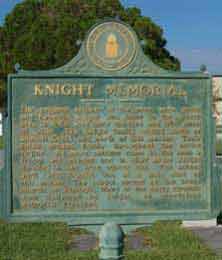 |
On September 18, 1926 the Florida West Coast was hit by a severe hurricane. One of the casualties of that storm was our Church - it was completely destroyed. The organ and beautiful pews were damaged beyond repair and the books water-soaked beyond redemption. The cast iron bell from our 1903 Church crashed to the ground as our Church building collapsed. After the hurricane, the bell was loaned to serve another Methodist Church in the area. The hurricane was a tragedy that left the community in shock. A great deal of building was occurring at this time due to the development of Venice by the Brotherhood of Locomotive Engineers who offered us land but it came with the stipulation that the Church must be used for all denominations. The pastor and members of our Church decided against accepting the land with these restrictions. |
|
| In 1927, Dr. Fred Albee donated land close to Dona Bay free of any restrictions and construction of a new Church began. It is believed that our Church was officially named Venice-Nokomis United Methodist Church at this time. Today our Sanctuary stands on the exact spot as the 1927 church. The flooring and plaster on the walls was not added to the Church until 1942 due to financial constraints. | 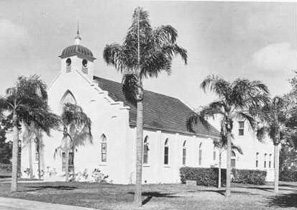 |
|
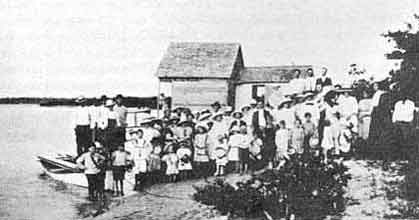 |
For years, some of our members use to pole their flat bottom boats down the shallow bays (traveling as much as 10 to 15 miles) to the Boathouse on Dona Bay each Sunday to hear Rev. Jesse Knight preach. They used the Boathouse to change into their "Sunday best" before walking the short distance to the Church. The property and boat dock where the Boathouse once stood is still owned by Venice-Nokomis United Methodist Church. | |
| In 1949, a tower was added to the Church and chimes were installed. The chimes play hymns three times per day and can still be heard throughout the area. During the 70’s, after considerable effort, our cast iron bell was returned to us. It now resides in a small tower built especially for it. The bell is one of only two church bells in the area that still actually rings. The cast iron bell is the oldest article we have representing our heritage | 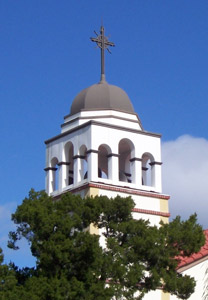 |
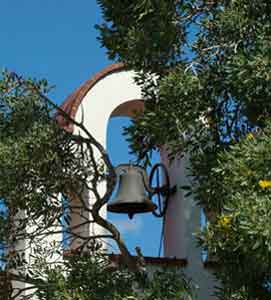 |
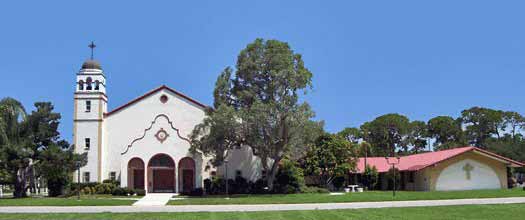 |
In 1978, it was determined that repairs and enlargement to the Church building were impractical and extremely costly so the decision was made to build a new Church. It was erected on the exact spot where our 1927 Church once stood. | |
| The Church was designed to be very similar to the old one and many items, such as, the ceiling lights, stained glass windows, and some of the pews were incorporated into the new Sanctuary. A beam from the old Church was used by Roy Bernius Sr. to make a remarkable cross to hang over the altar. |  |
|
In 1979, a section of the old Fellowship Hall was turned into a Memorial Chapel. It was named the Blalock Memorial Chapel in honor of two members whose lives and efforts have meant so much in the history of our wonderful Church. The Chapel was designed to capture as much as possible the tone and atmosphere from our 1927 Sanctuary. It contains some of the pews, altar rail, pulpit desk, lecturn, chairs, and beautiful altar, the brass and brocaded satin paraments from the old Church. On Christmas Eve, of the year 2000, Venice-Nokomis United Methodist Church celebrated its 132nd Birthday. That can be broken down to 132 years or 48,213 days, 1,157,112 hours, 69,426,720 minutes or 4,165,603,200 seconds! On September 14, 2001 our Church once again sustained damage from a storm. This time it was from Tropical Storm Gabrielle. A large and very beautiful oak tree on the Church property was destroyed. The tree was approximately 70 years old and considered an area landmark in Nokomis. On the first Sunday after the storm the congregation worshipped with only partial electrical power inside the Sanctuary. There were a few lights, no air conditioning or water, and the pipe organ was silenced. A palm tree located at the entrance of the parking lot (close to the oak tree) was also uprooted by the storm. This palm tree was considered “unique” by many horticulturists because it had seven heads.
There is more of God’s work for us to do. We honor the past! We serve the present! We look forward to the future!
Venice-Nokomis United Methodist Church
208 Palm Avenue
Nokomis, Florida 34275
vnumc@daystar.net
(941) 488-413